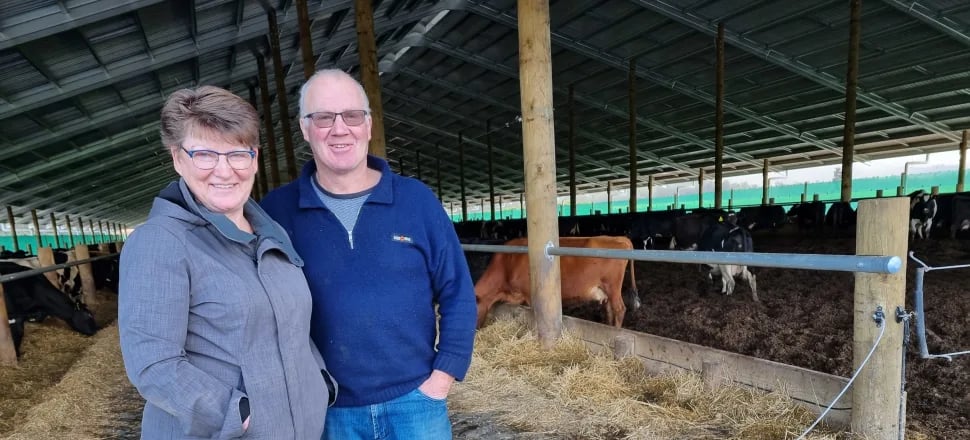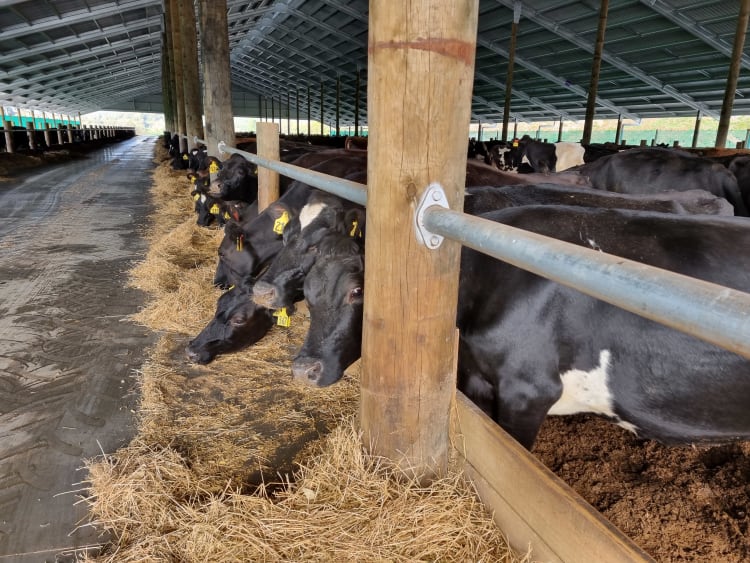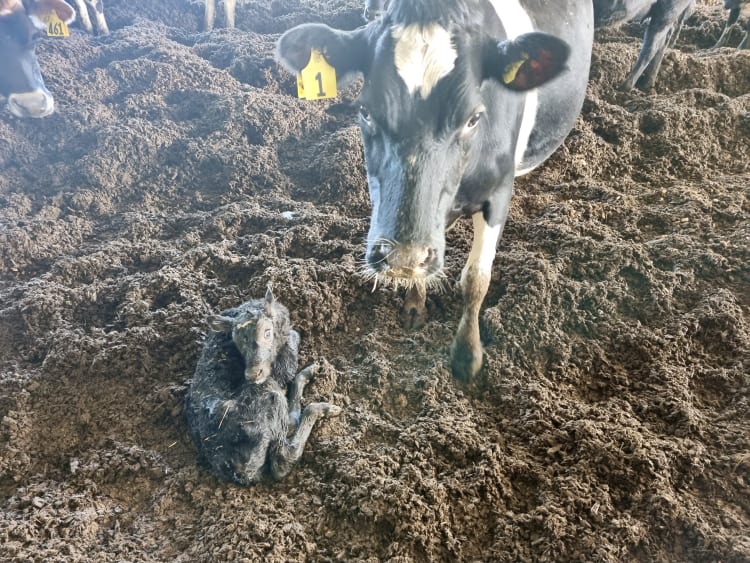‘West Coast’ cow cockies say ‘get off the grass’ to new rules
When stock wintering rules designed to protect waterways were imposed on a century-old South Island dairying property, the owners bet their nest egg on building an enormous barn

It wasn’t the mother of all floods in 2013 that convinced West Coast dairy farmers Matt and Carmel O’Regan to move their cows indoors.
Nor was it the latest summer deluge in February, when the old flood gauge at Inangahua Landing vanished from sight under muddy waters, along with thousands of hectares of farmland.
After three generations at Coal Creek, the family is used to floods.
Instead, it was the new freshwater regulations, designed to protect rivers, that triggered their decision to invest $2 million in a composting barn for their herd.
The giant structure, bigger than a rugby field, is the first of its kind in Buller and now looms large on the local landscape - despite a tasteful $100,000 paint job to fade its roof into the impossibly scenic backdrop.
In mid-May the O’Regans moved their 450 in-calf cows under cover for the first time and they’ve been there ever since - apart from a few fine-day outings to kick up their heels in the sun.
“The thing that drove us to the barn was the change in the wintering rules for farming,” Matt O’Regan says.
“When they first came out I was extremely angry - really pissed off. It was the one-size-fits-all aspect of it, designed by Wellington bureaucrats with rules that were ludicrous for us here on the coast.


One size doesn’t fit all
The new rules meant the O’Regans couldn’t keep farming the way they had for 40 years in their picturesque valley bounded by the Brunner and Paparoa ranges and criss-crossed with fast-flowing streams.
“The new rules meant we couldn’t take stock across the creeks more than once a month; the level of pugging allowed meant we couldn’t use some paddocks at all; we couldn’t water stock or put them on feed crops.
“Yet you’d struggle to have any effect on these creeks because of the sheer volume of water.”
The streams on the O’Regan farm can turn feral overnight, tearing away fences and chunks of hard-won pasture.
In that setting, rules designed to protect water rather than productive pasture were hugely frustrating, O’Regan says.
“My family’s been here at Coal Creek for 100 years and loved the place and we haven’t damaged the environment. It’s like having a lovely home and someone coming in and telling you how to look after it,” O’Regan says.
But after the anger subsided, the couple turned their minds to ways of adapting.
“We went through a stage of thinking we’d reduce stock numbers, grow a smaller area of crops, maybe get consent for a stand-off pad or something.
“But it all seemed like a short-term fix because we just know the rules aren’t going to get any easier. They have tweaked them a bit since but we felt we needed to protect the gains we’ve made over 40 years.”
Not-so-foreign concept
In his years as chairman of Westland Milk Products, O’Regan had checked out cow barns in Asia and Europe, and later in Canada.
“It was something that always appealed to me, having cows under cover - they’re healthy and more productive. But I never liked the idea of having them on cold hard concrete the way a lot of farms do overseas.”
Enter the concept of the composting barn. The animals stand, lie and excrete on a bed of wood chips or sawdust that’s mechanically aerated to promote decomposition.
Once a year, the bedding is changed and the compost spread over the pasture, resulting in a much-reduced nitrate burden on soil and water.
It seemed like the best option and a way to future-proof the farm, O’Regan says.
“I’ve spent my life developing farmland. I’ve brought in 300ha of scrub and swamp that’s now good dairy pasture. But with the constant wet winters and springs, we’re not growing as much grass as we were 10 years ago.”
Accepting that wet is the new normal, the couple kissed goodbye to their retirement nest egg and commissioned Greymouth’s Philco Contracting to build the giant Aztech-designed barn.
“We put in a base layer of gravel, then a bed of pine wood chips 800mm deep, then once a day we move the cows out, bay by bay and put the tractor through with a cultivator to rip the bed and aerate it.”
The aim is to create a warm non-smelly layer that is kept dry by the heat from composting. So far it’s working.
“The cows are in the best condition ever pre-calving and we’ve used about 20 percent less feed because there’s no waste compared with feeding out.”

Pong-free zone
From a reporter’s perspective, it’s fair to say that dairy-farm visits usually involve bracing yourself for the pong and loud mooing. But the first thing you notice at the O’Regan barn is the absence of either.
More than 450 cows, closely packed in three long bays, might be expected to generate some noise and odour. But the animals are calm and quiet, poking their heads through railings to chomp at feed spread on concrete laneways that are polished to a smooth finish to protect their tongues.
Newborn calves struggle to their feet or lie placidly on the warm wood chips with their mothers.
The only detectable aroma is a malty one coming from their feed - a mix of Canterbury rye grass straw, maze kernels grown on the property, palm kernel and a mineral supplement.
It’s early days for the indoor farming venture, and in one of the bays the composting process is not working as it should and the wood chip will need replacing, O’Regan says.
But it’s a matter of trial and error and so far the results have been impressive.
“We kept some of the cows we’d normally cull before winter and we had our best May milk production ever. Then we milked right through June and did 50 percent more milk than last June.”
Indoor dairy farming is also kinder to staff, Carmel O’Regan says.
“You’re not out there in the rain and cold trying to write in your notebook. Our manager, Luke, can do his calving checks at night now without his coat. It makes it much nicer for the people as well as the cows.”
And the cows have the best of both worlds, she says.
“When they’re let out into the paddock they jump around like teenagers. But from the second night, when they heard the gates click to open, they practically galloped back into the barn.”
Muddling the message
The dairy-barn trend is growing on the West Coast. The O’Regans’ is the first of its kind in Buller, but barns and herd shelters have begun popping up further south from Hari Hari to the Grey Valley.
For a country that’s traditionally spruiked the nutritional superiority of grass-fed dairy, the trend towards indoor farming does raise some potential marketing issues, Matt O’Regan concedes.
But the cost of making the change will limit its spread in the short term, and for many conventional farmers, it will be unnecessary.
“Any dairy system done well is good, and we’re not preaching that others should do the same as us. We’re doing this because in our situation it means we can farm better.”
In any case, the herd isn’t confined to barracks 24/7, O’Regan says.
“The cows will be in there whenever there’s a risk of damaging pasture and whenever there’s not enough grass for them in the area allocated for the day and they need a supplement.
“On a fine day they’ll probably go to the shed for two hours just for a feed. I’m still a grass farmer. Just one with a barn.”
This article was prepared by Newsroom
for the original article and to listen to the story, click here...
https://www.newsroom.co.nz/wet-coast-cow-cockies-say-get-off-the-grass-to-new-rules
